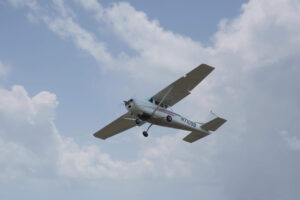Mitigating risk is a fundamental aspect of aviation safety. Pilots can enhance their decision-making process by using the PAVE checklist, which divides flight risks into four categories: Pilot-in-command (PIC), Aircraft, enVironment, and External pressures. This structured approach helps pilots assess and manage potential hazards before every flight, ensuring a higher level of safety and preparedness.
For those who are visual learners, check out our video below!
https://www.youtube.com/watch?v=W5pYo_u4L7c&t=57s
Understanding the PAVE Checklist
The PAVE checklist serves as a mnemonic device that pilots can use to systematically evaluate the risks associated with a flight. By examining each category, pilots can identify potential issues and decide whether these risks can be managed safely. If not, the pilot should consider canceling the flight. Setting personal minimums for each risk category is a practical way to manage these risks effectively.
P – Pilot-in-Command (PIC)
The pilot is a critical factor in flight safety. The PIC must evaluate their readiness for the flight, considering:
- Experience: Do I have sufficient experience for this flight?
- Recency and Currency: Am I current with my flying skills and knowledge?
- Physical and Emotional Condition: Am I physically and emotionally fit to fly?
The IMSAFE checklist is a useful tool for assessing these aspects:
- I – Illness: Do I have any illness or symptoms?
- M – Medication: Am I taking any medications that could affect my performance?
- S – Stress: Am I experiencing any stress that could impact my ability to fly?
- A – Alcohol: Have I consumed alcohol recently?
- F – Fatigue: Am I well-rested and alert?
- E – Emotion: Am I emotionally stable and focused?
A – Aircraft
The aircraft’s capabilities and limitations must be thoroughly evaluated:
- Suitability: Is this the right aircraft for the flight?
- Familiarity: Am I familiar with and current in this aircraft?
- Equipment: Is the aircraft equipped for the flight, including instruments, lights, navigation, and communication equipment?
- Performance: Can the aircraft handle the planned load, runway conditions, and altitudes?
- Fuel: Does the aircraft have sufficient fuel for the trip, including reserves?
V – EnVironment
Environmental factors, particularly weather and terrain, play a significant role in flight safety:
- Weather: What are the current and forecasted weather conditions, including ceiling and visibility, winds, turbulence, thunderstorms, and icing?
- Terrain: What is the terrain like along the route, and are there any obstacles or high-altitude areas?
- Airports: Are the destination and alternate airports equipped with necessary lighting and navigation aids? Are there any NOTAMs (Notices to Airmen) affecting these airports?
- Airspace: Are there any airspace restrictions or TFRs (Temporary Flight Restrictions) along the route?
- Nighttime: If flying at night, are all aircraft lights functional, and is the pilot prepared for night operations?
E – External Pressures
External pressures can create a sense of urgency that compromises safety. Pilots must manage these pressures effectively:
- Expectations: Are there passengers waiting or other pressures to complete the flight?
- Personal Goals: Is there a desire to prove oneself or meet personal goals at the expense of safety?
- Time Constraints: Is there a time pressure to arrive by a specific deadline?
Managing External Pressures
To manage external pressures, pilots can establish personal standard operating procedures (SOPs):
- Allow Extra Time: Plan for potential delays and include extra time for fuel stops or weather-related diversions.
- Alternate Plans: Have backup plans, such as alternate transportation options or backup reservations.
- Communicate Expectations: Inform passengers and others about the possibility of delays and manage their expectations.
- Carry Essentials: Bring essential items on every flight to avoid pressure to return home quickly.
Conclusion
The PAVE checklist is an invaluable tool for pilots to assess and manage flight risks. By systematically evaluating the Pilot, Aircraft, enVironment, and External pressures, pilots can make informed decisions that enhance flight safety. Remember, the goal is to manage risk, not to eliminate it entirely, but to ensure it is at an acceptable level for safe flight operations.
FAQs
Q1: How can I set personal minimums using the PAVE checklist? Personal minimums should be based on your experience and comfort level. For example, if you are comfortable with a 10-knot crosswind, set that as your limit until you gain more experience.
Q2: What should I do if I encounter unexpected risks during a flight? If unexpected risks arise, reassess the situation using the PAVE checklist. Consider diverting to a safer location or returning to the departure point if the risks cannot be managed.
Q3: How often should I review my personal minimums? Regularly review and adjust your personal minimums as you gain more experience and confidence. It’s important to continually evaluate and update them based on your current proficiency.




